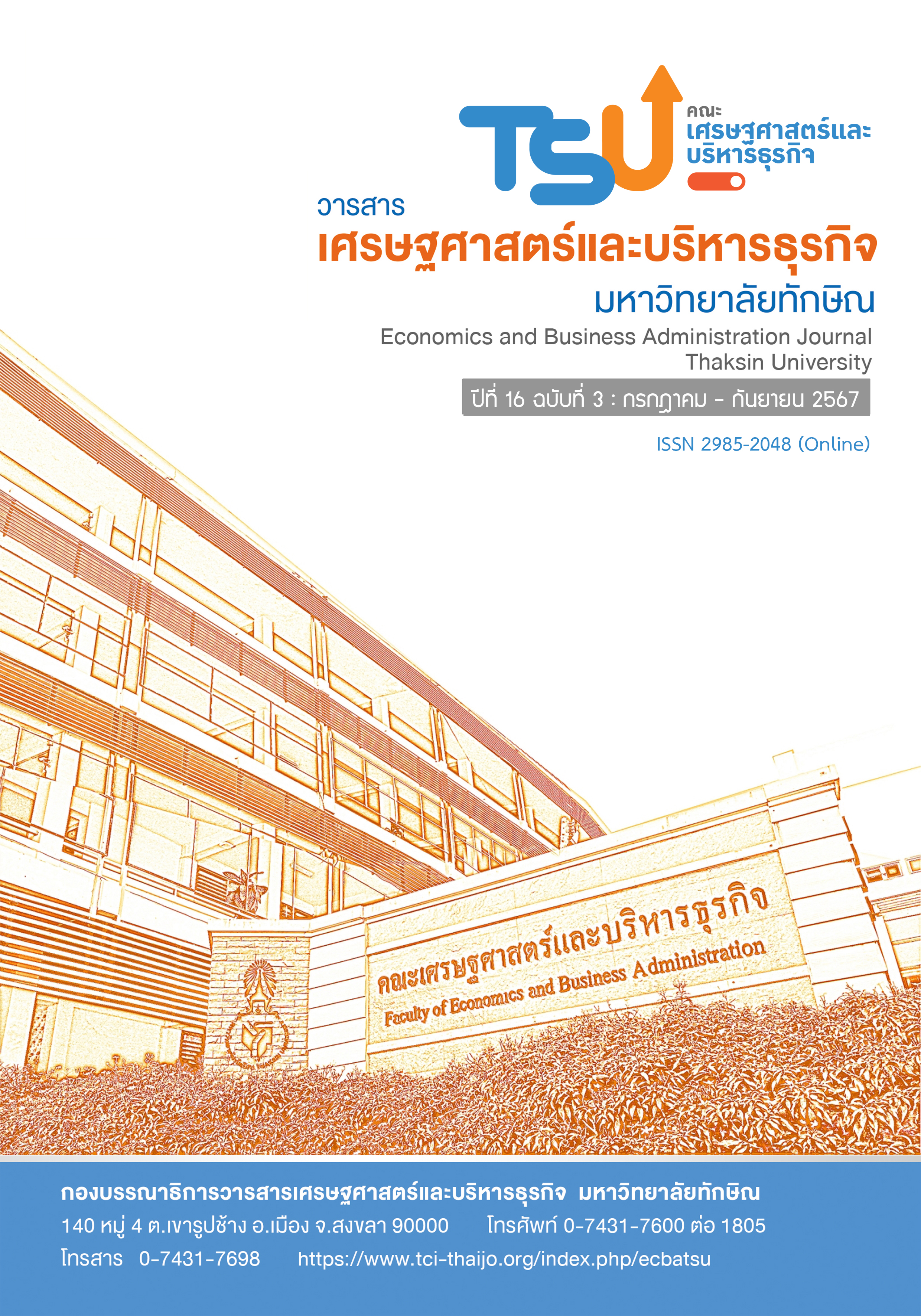The Competitive Strategy of Small Operators of Food Business
DOI:
https://doi.org/10.55164/ecbajournal.v16i3.266582Keywords:
Competitive Strategy, Small Operators of Food-Business, Out perform PerformanceAbstract
This research investigates how small operators adapt to the environment that is changing in a brittle way. The objectives of the study are to: 1) identify the companies’ competitive strategies 2) evaluate the demographics characteristics of the companies whose performance level is above average and 3) Identify the changing pattern of the successful strategy of small operators.
The research employs quantitative techniques. A questionnaire, pretested for its reliability and content validity, was sent to 383 business operators in the city municipality of Petchburi. There were 383 responses for a response rate of 100%. The statistical methods used to analyze the includes frequency, percentage, means, standard deviation, and clustering. The findings indicate that most vendors prepare made-to-order items. The small operators of food business the most importance on innovation strategy,The findings show that above average performers focus on innovations and hybrid generation group. Innovation principles should be utilized.
References
Ali Shah, S.A., & Ahmad, M. (2019). Entrepreneurial Orientation and Performance of Small and Medium-sized Enterprises Mediating Effects of Differentiation Strategy. Competitiveness Review: An International Business Journal, 29(5), 551-572.
Bargoni,A., Bertoldi, B., Giachino, C., & Santoro, G. (2022). Competitive Strategies in the Agri-food Industry in Italy During the COVID-19 Pandemic: An Application of K-means Cluster Analysis. British Food Journal, 124(12), 4782-4799.
Barnett W.P., & Burgelman R.A. (1996). Evolutionary Perspectives on Strategy. Strategic Management Joumal, 17(1), 5-19.
Bearden, W., O., Netemeyer, R, G., & Mobley, M. F. (1993). Handbook of Marketing Scales: Multi-item Measures for Marketing and Consumer Behavior Research. Thousand Oaks, CA: Sage.
Brotherton, B., & Adler, G. (1999). An Integrative Approach to Enhancing Customer Value and Corporate Performance in the International Hotel Industry. International Journal of Hospitality Management, 18, 261-272.
Block, J., Kohn, K., Miller,D. & Ullrich,K. (2015). Necessity Entrepreneurship and Competitive Strategy. Small Business Economics, Springer, 44(1), 37-54.
Box, T.M., & Miller, W.D. (2011). Small-Firm Competitive Strategy. Academy of Strategic Management Journal, 10(2), 55.
Burgelman, C., Christensen, C., & Wheelwright. (2009). Strategic Management of Technology and Innovation (5th ed.). New York: McGraw-Hill.
Cui, J. & Jao, H. (2011). Dynamic Capabilities, Strategic Stakeholder Alliances and Sustainable Competitive Advantage: Evidence from China. Corporate Governance Journal, 11(4), 386-398.
Grando,S., Bartolini, F., Bonjean, I., Brunori, G., Mathijs, E., Prosperi, P., & Vergamini, D. (2020). SMALL Farm’ Ehaviour: Conditions, Strategies and Performances, Innovation for Sustainability Research in Rural Sociology and Development, 25, 125–169.
Hanifah, H., Halim, H.A., Ahmad N.H., & Vafaei-Zadeh, A. (2019). Emanating the Key Factors of Innovation Performance: Leveraging on the Innovation Culture among SMEs in Malaysiak. Journal of ASIA Studies, 13(4), 559-587.
Hutahayan, B. (2009). Factors Affecting the Performance of Indonesian Special Food SMEs in Entrepreneurial Orientation in East Java. Asia Pacific Journal of Innovation and Entrepreneurship, 13 (2), 231-246.
Jantunen, A., Ellonen, H-K., & Johansson, A. (2012). Beyond Appearances – Do Dynamic Capabilities of Innovative Firms Actually Differ?. European Management Journal, Elsevier, 30(2), 141-155.
Kaliappen, N., & Hilman, H. (2017). Competitive Strategies, Market Orientation Types and Innovation Strategies: Finding the Strategic Fit. World Journal of Entrepeneurship. Management and Sustainable Development, 13(3): 257-261.
Kim, E., Nam, D., & Stimpert, J. L. (2004). The Applicability of Porter’ s Generic Strategies in the Digital Age: Assumptions, Conjectures, and Suggestions. Journal of Management, 30(5), 569-589.
Kim-Soon,N.,Ahmad, A.B.,Wei Kiat, C. & Rizad Md Sapry,H. (2017). SMES Are Embracing Innovation for Business Performance. Journal of Innovation Management in Small & Medium Enterprises, DOI:10.5171/2017.824512.
Lamont, B. T., Marlin, D., & Hoffman, J. J. (1993). Porter’s Generic Strategies, Discontinuous Environments, and Performance: A Longitudinal Study of Changing Strategies in the Hospital Industry. Health Services Research, 28(5), 618-623.
Luo, Y., & Zhao, H. (2004). Corporate Link and Competitive Strategy in Multinational Enterprises: A Perspective from Subsidiaries Seeking Host Market Penetration. Journal of International Management, 10(1), 77-105.
Office of Small and Medium Enterprise Promotion. (2023). Yearly Situation Report. Retrieved from www.sme.go.th/upload/mod_cms/332/files/20200206092118- 20447-0.pdf.
Parnell, J.A., Long, Z., & Lester, D. (2015). Competitive Strategy, Capabilities and Uncertainty in Small and Medium Sized Enterprises (SMEs) in China and the United States. Business Management Decision, 53(2), 402-43.
Phetchaburi Municipality. (2023). General Information. (Online). www.phetchaburicity.go.th Retrieved January 4, 2023
Phetchaburi Municipality. (2023). Phetchaburi General Information. Retrieved from www.opsmoac.go.th/phetchaburi-dwl-files-441991791902.
Porter, M. E. (1980). Competitive Strategy: Techniques for Analyzing Industries and Competitors. New York: Free Press.
Porter, M. E. (1985). Competitive Advantage: Creating and Sustaining Superior Performance. New York: Free Press.
Punj, G., & Stewart, D.W. (1983), Cluster Analysis in Marketing Research: Review and Suggestions for Application. Journal of Marketing Research, 20(1), 134-148.
Samsir, S. (2017). The Effect of Leadership Orientation on Innovation and Its Relationship with Competitive Advantages of Small and Medium Enterprises in Indonesia. International Journal of Law and Management, 60(2), 530-542.
Scarborough, N. M., & Zimmerer, T. W. (2008). Essentials of Entrepreneurship and Small Business Management (5th ed.). Upper Saddle River, NJ: Prentice Hall.
Schumpeter, J. A. (1934). The Theory of Economic Development. Cambridge, M.A.: Harvard University Press.
Stettinius, W. D., Wood, R., Jr., Doyle, J. L., & Colley, J. L., Jr. (2005). How to Plan and Execute Strategy: 24 Steps to Implement any Corporate Strategy Successfully. New York: McGraw-Hill.
Tavassoli, S., & Karlsson, C. (2015). Firms’ Innovation Strategies Analyzed and Explained (No. 396), Royal Institute of Technology. CESIS-Centre of Excellence for Science and Innovation Studies, available. at: www.cesis.se.
Terziovski, M. (2010). Research Notes and Commentaries Innovation Practice and Its Performance Implications in Small and Medium Enterprise (SMEs) in the Manufacturing Sector: A Resource-Based View. Strategic Management Journal, 31(1), 892-902.
Varadarajan, R. (2018). Innovation and Strategy. Review of Marketing Research, 15(1), 143-166.
Yamane, T. (1967). Elementary Sampling Theory. Englewood Cliffs, NJ: Prentice-Hall.
Wamalwa, H., Upadhyaya, R., Kamau, P., & McCormick,D. (2019). Strategies of Kenyan Firms: A Case Study of Food Processing Firms in Nairobi. African Journal of Economic and Management Studies, 10(4), 507-520.
Downloads
Published
How to Cite
Issue
Section
License
Copyright (c) 2024 Faculty of Economics and Business Administration, Thaksin University

This work is licensed under a Creative Commons Attribution-NonCommercial-NoDerivatives 4.0 International License.




